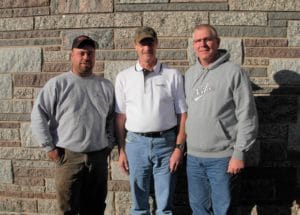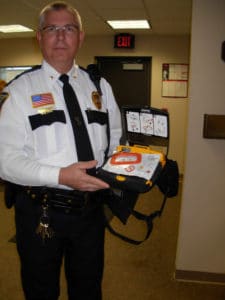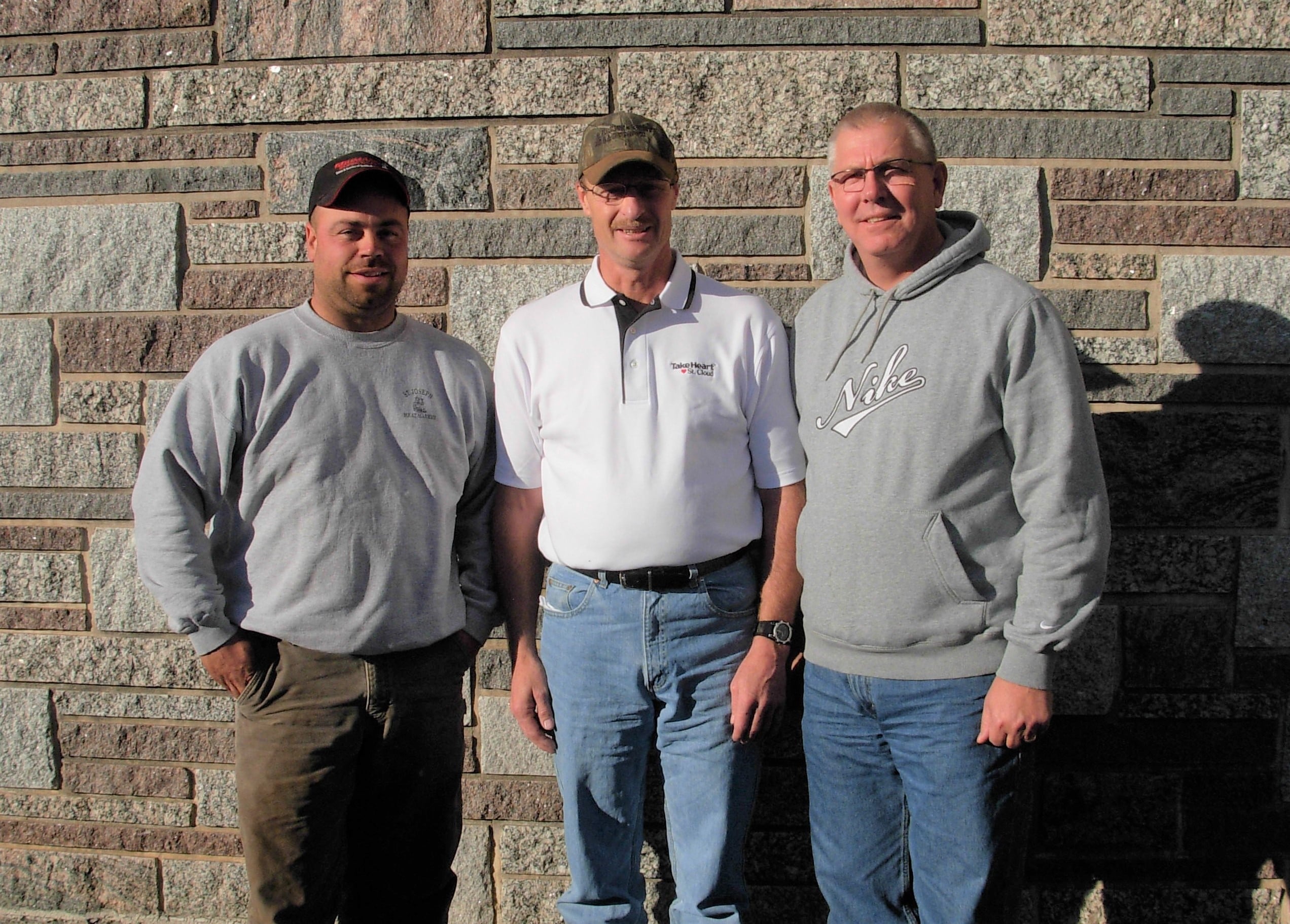by Dennis Dalman
news@thenewsleaders.com
Mark Hilsgen of St. Joseph, a survivor of sudden cardiac arrest, is hoping St. Joseph will soon have one or more “defibrillator save stations.”
It’s not surprising since an automated external defibrillator (AED) is what saved his life almost 10 years ago.
“They should put save stations in as central a location as possible, where most people are,” he said. “I was lucky because there happened to be one right there when I needed it.”
In 2010, the dramatic saving of Hilsgen’s life was the subject of a St. Joseph Newsleader story written by his sister-in-law, Newsleader reporter Cori Hilsgen.
Hilsgen, who just turned 61 on March 19, recalled the crisis. The day was Sunday, Oct. 17, 2010. He was attending morning Mass at St. Joseph Catholic Church. He was alone because the day before he and his family had attended a nephew’s wedding so he thought it best if his wife and daughters stayed home and got some extra sleep.
Right after taking communion in church, Hilsgen walked back to the pew, sat down and keeled over. It was in that moment of crisis that a rapid and remarkable series of coincidences began to happen. Bob Prom, sitting not far from Hilsgen, nudged his wife, alarmed by Hilsgen’s apparent medical problem. Pete Jansky, who was then the St. Joseph police chief, quickly noticed the slight commotion and hurried over to Hilsgen. (Years before Hilsgen and Jansky took a cardiopulmonary resuscitation (CPR) course together and later they saved a man who’d had a cardiac arrest at a shopping mall in St. Cloud.)
In the church, suddenly bristling with commotion and concern, CPR was started on Hilsgen. Those who gathered by Hilsgen included Mary Jo Lemke of St. Joseph, a cardiac nurse at St. Cloud Hospital; Theresa Lahr, a nurse in Hutchinson visiting her daughter in St. Joseph that Sunday; St. Joseph Dr. Thomas Newton; and – most amazingly – St. Joseph First Responder Justin Honer, who just happened to have an AED in his pickup because he’d taken an AED course the night before and hadn’t returned the AED yet to the police station. Honer dashed out to retrieve the AED. Consulting with Jansky, he used the machine to shock Hilsgen’s heart to life. Two shocks were required, and soon an ambulance whisked Hilsgen to the hospital, where he spent four days in recovery.
Hilsgen, 61, who works at Manion’s Wholesale Building Supplies, said he remains deeply grateful that he was in church that morning.
“All the people I needed to be there were there, just when I needed them,” he said. “I still talk to them, still thank them and even give them hugs.”
Just as grateful to those people as Hilsgen are his wife, Lisa, and their twin daughters Amber and Allie, now 14, who were only 5 when they went to the hospital to give hugs to their father who had almost died.
Hilsgen said his heart-health has been fine. He credits Dr. Jamie Pelzel, who lives just south of St. Cloud, for noticing not long after the cardiac arrest there was something very unusual about Hilsgen’s heart condition – enough concern to require him to be fitted with a pacemaker.
Defibrillator
An automated external defibrillator is a small, portable machine that delivers an electrical shock to a person who has been stricken by sudden cardiac arrest. That happens when the electrical system in the heart goes haywire and suddenly stops the heart from pumping. Death is certain within 10 minutes, at most, unless cardiopulmonary resuscitation is administered and/or a defibrillator is used. Each AED gives voice prompts about how to use it.
Save stations
There is currently a coordinated effort to install at least 25 AED Save stations in the greater St. Cloud area, possibly including St. Joseph. So far, there are just three – two in St. Cloud, one in Sartell.
AEDs are now common in public places such as schools, athletic fields, law-enforcement stations, squad cars, ambulances and hospitals. However, they are unfortunately off limits to the general public, especially after hours when they are inaccessible in locked-up buildings.
That is why the concept of AED Save stations began. Save stations are secured boxes that can be placed in neighborhoods or other spaces. Each contains an AED that can be used right there or taken from the box to be used elsewhere in a crisis. The boxes are protected by an automatic system from hot and cold extremes of weather; each has an alarm system; and each box can automatically send an alarm to neighbors when an emergency occurs (triggered when the box is opened and defibrillator removed).
Joel Vogel of St. Joseph, a member of the Mending Hearts organization, is a strong advocate of AED Save stations and inspired a Sartell friend to obtain a grant for the one now installed in Sartell.
Thanks to the efforts of Vogel and others, the CentraCare Health Foundation started a pilot program to help install at least 25 more AED Save stations in the greater St. Cloud area in the first half of 2019. Neighbors get together, raise funds (about $5,000) and then CentraCare gives the rest. The initial fundraising is for the basics at the Save site, including the structure itself and any electrical-connection lines required. As part of the Save station effort, CentraCare also provides CPR-training courses, often taught by cardiac-arrest survivors.
Learn, learn, learn
AED advocates all emphasize that knowledge is power, and the more people learn about heart problems, CPR and AEDs the more lives will be saved. Even children should be taught CPR and how to use an AED, they advise.
The basic difference between sudden cardiac arrest is when the heart stops due to a kind of electrical seizure. A heart “attack,” on the other hand, is caused usually by some kind of blockage in an artery when the heart does not get enough oxygen. Many who suffer heart attacks have time to get emergency treatment. That is not true with those who suffer cardiac arrest, which is so sudden that unless someone else is present to help, death is virtually certain. AEDs can also be used when people are suffering “heart attacks,” as well as sudden cardiac arrests.
About 360,000 people die of cardiac arrest each year, and 80 percent of them happen at home. Only about 8 percent of them survive. However, if CPR and/or AEDs are used, the survival rate is 70 percent.

The life of Mark Hilsgen (center) was saved on Oct. 17, 2010 when he suffered a sudden cardiac arrest in St. Joseph Catholic Church. Two of the men who rushed to save his life are Justin Honer (left) and Pete Jansky, who were both attending the church service that morning. Honer, at that time assistant fire chief, happened to have a defibrillator in his truck, which “shocked” Hilsgen’s heart back to life. Jansky, at that time, was the police chief of St. Joseph. This photo was taken in November 2010.

In this photo, taken in November 2010, Pete Jansky, at that time the police chief of St. Joseph, holds an automatic external defibrillator of the kind used to save the life of St. Joseph resident Mark Hilsgen.




